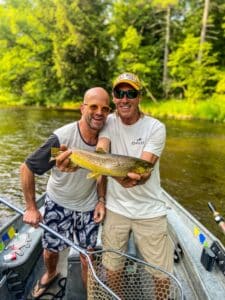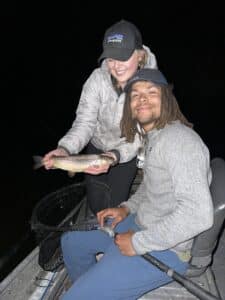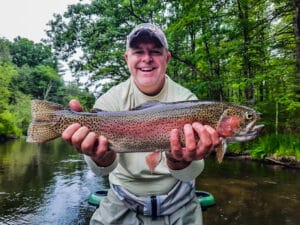I just want to say thank you to everyone who supported us and fished with us this summer. It was truly a great summer and another one for the books. As it slowly comes to an end we look forward to the next peak season and all the people we are going to reunite with as well as all the new people we are about to meet.
Our water temps have finally dropped down into the high 50’s and day time temps are in the mid to low 70’s. This week’s weather is calling for mid 70’s and possible showers near the end of the week.
Dry fly fishing during the day starting out early has been quite effective. As well as the evening fishery. The Damsels are starting to disappear and a large assortment of grasshoppers have been seen flying all around. Brown, green, yellow and orange seem to be the most common colors. Mousing has been very productive. I haven’t seen a lot of pressure on the water at night either. just a couple people here and there.
Don’t look now but Salmon are slowly starting to show up in the river. Just one here and a couple there. Once we get a north west wind and the lake flips, hold onto your shorts. It’s going to be game on. Judging from the lake reports there should be some pretty big fish again this year. If the steelhead reports out there are any reflections of what’s to come this fall we should have awesome numbers and really big fish.
Faith Ann and Kevin have been working very hard to get the shop stocked up with all the latest flies and gear for this fall season. We would like to welcome Trevor Ferguson our newest member of the team. Stop by and say hi, introduce yourself to the team and let us help you ensure you have the best destination trip ever.
Sunday August 6th the DNR did the Lampricide Application to the Pere Marquette River. The water will have chemicals in it and or be visible to the naked eye between noon Sunday and and 1:00pm Monday afternoon. I went down and checked out the river about 7:00pm Sunday evening and the river looked yellow as all get out. Fishing will probably taper off after the trout gorge on the baby lamprey and larva floating down the river today.
If you are curious about the lamprey and how they got here and how they’re trying to keep them at bay, keep reading:
The sea lamprey is a primitive eel-like fish distinguished from other fish by its lack of paired fins and jaws. The sea lamprey, closely related to the primitive hagfish, is an anadromous species endemic to the Atlantic Ocean. Most of the life of the sea lamprey is spent as a larva burrowed in the sediment of freshwater streams. In this life stage the animal is not harmful to other fish and feeds by filtering food from stream water. The sea lamprey may remain in the larval stage from 3 to more than 17 years before metamorphosing into the parasitic (predatory) stage. The parasitic-phase lamprey feeds by attaching to fish and rasping deep wounds from which blood, body fluids, and flesh are drawn. The results of such attacks are often fatal for the host fish. II. History The sea lamprey was first reported in Lake Erie in 1921. They rapidly spread throughout the upper Great Lakes and were well established by the 1940s. By 1950, lake trout (Salvelinus namaycush), a primary prey species, were nearly extirpated in lakes Michigan and Huron. Early attempts to control sea lampreys began in the 1950s with the installation of mechanical traps and electrical weirs in spawning streams, but these measures were largely unsuccessful. No effective control was accomplished until the advent of a chemical control program in 1958. A search for an effective lampricide began in the 1950s. After toxicological screening of nearly 6000 chemicals, two classes of compounds emerged as likely candidates, halogenated nitrophenols and salicylanilides. From these classes of compounds two lampricides, TFM (3-trifluoromethyl-4-nitrophenol) and Bayluscide (2′,5-dichloro-4′- nitrosalicylanilide) were developed and have been used successfully for the control of larval sea lampreys in the Great Lakes basin. TFM and Bayluscide were registered as restricted use pesticides in 1960. Both lampricides were successfully reregistered in 1997 in the U.S. and in Canada. III. Lampricide Formulations Lampricide formulations are registered by the USFWS as restricted use pesticides in both the United States and Canada. Use of these products is limited to certified applicators of SLC 04-001.11 20 the USFWS, DFO, and provincial and state fish and game employees. Pesticide labels (Appendix E) have been issued that define use practices in their respective countries. The “Restricted Use” designation restricts a product, or its uses, to use by a certified pesticide applicator or under the direct supervision of a certified applicator. Pesticide applicators must adhere to all label requirements and follow all precautionary statements. Among these stipulations are the following: lampricides are to be handled and applied only by trained personnel; local, state, and provincial fish and game agencies must be notified before use; municipalities which use stream water as a potential source of drinking water must be notified 24 hours prior to treatment; agricultural irrigators must be informed 24 hours in advance of a treatment that they must turn off irrigation systems for a 24 hour period during and after treatment; pretreatment surveys must be conducted to determine larvae populations; on-site water chemistry analyses must be conducted to determine the minimum concentration of lampricide required to kill larval sea lampreys and the maximum concentration that can be used without causing undue non-target mortality; concentrations of lampricide in the water must be monitored by colorimetric analysis, or High Performance Liquid Chromatography (HPLC); and specified personal safety precautions must be followed. A. TFM The chemical compound 3-trifluoromethyl-4-nitrophenol also known as α,α,α Trifluoro-4-nitro-m-cresol (TFM) is a halogenated mononitrophenol with the molecular formula C7H4F3NO3, and a molecular weight of 207.1. TFM has a pKa of 6.07 + 0.03, and exhibits a maximum absorbance at 395 nm (for the phenolate ion) and 295 nm (for the unionized form). 1. Analytical Standard This is a purified form and distributed by Sigma-Aldrich, St. Louis, Missouri. It is a light yellow crystalline substance with a purity of 99 percent active ingredient. The concentrations of TFM field standards used during lampricide applications are verified against a TFM analytical standard. 2. TFM (TOP:012) TFM is produced as a liquid formulation of the sodium salt that contains about 33 percent active ingredient (free cresol) with the remainder primarily isopropanol and water. TFM (common names; Lampricide Sea Lamprey Larvicide, Sea Lamprey Larvicide Lamprecid®, TFM HP Sea Lamprey Larvicide) is produced under USEPA registration number 6704- 45, and Health Canada Pest Control Products numbers 21124 and 11763. TFM is manufactured by Iofina Chemical, Inc., 1025 Mary Laidley Drive, Covington, Kentucky 41017; and by Weylchem (Deutschland) GmbH, 65933 Frankfurt/Main, Germany (distributed by Weylchem (America) Inc., 3411 Silverside Road, Wilmington
If you still want more information on this subject go to www.sealamprey.org
Cheers,
Frank


